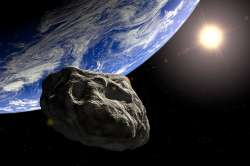Buckle up! Large three-mile-wide asteroid Florence to whiz past Earth on Friday
NASA says Asteroid Florence, a large near-Earth asteroid, will pass by Earth on at 5.35 PM IST Friday and will be visible through telescopes for several nights

Planet Earth is set for a close encounter as a rock measuring 4.4 km (2.7 miles) passes by our planet on Friday. US space agency NASA informed that Asteroid Florence, a large near-Earth asteroid, will pass by Earth on at 5.35 PM IST today, September 1, 2017. But you don’t need to don your Bruce Willis suits to save the Earth from ‘Armageddon’. Not yet, or the next century.... or many after that!
Here's why. NASA says that the closest Asteroid Florence gets to the Earth will be at a distance of about 4.4 million miles, (7.0 million kilometers, or about 18 Earth-Moon distances).
Moreover, NASA scientists do not see Asteroid Florence as a threat for the next several centuries, or over the next several millennia either. “It's possible this asteroid could threaten our planet in the far distant future, but it's unlikely," CNN quoted Paul Chodas, manager of NASA's Center for Near-Earth Object Studies, as saying.
Still, the event this evening is special in many ways. NASA said in a statement that Florence is among the largest near-Earth asteroids that are several miles is size.
Epic Encounter
While asteroids fly past Earth on a regular basis, they're usually only a few meters wide. However, Florence will be the largest Near-Earth Object (NEO) to whiz past the planet since NASA began tracking them some 20 years ago.
“While many known asteroids have passed by closer to Earth than Florence will on September 1, all of those were estimated to be smaller,” said Paul Chodas, manager of NASA’s Center for Near-Earth Object Studies (CNEOS) at the agency's Jet Propulsion Laboratory in Pasadena, California.
“Florence is the largest asteroid to pass by our planet this close since the NASA program to detect and track near-Earth asteroids began.”
Since 1998, when NASA first began tracking potentially hazardous objects, it has spotted over 16,000 NEOs. However, the 2017 encounter is the closest by this asteroid since 1890 and the closest it will ever be until after 2500.
Why is it Significant?
Scientists will be watching this large boulder closely. They believe that any asteroid larger than half-mile to a mile (one to two kilometers) in size could have worldwide effects if it hits the planet.
“Florence is expected to be an excellent target for ground-based radar observations. Radar imaging is planned at NASA's Goldstone Solar System Radar in California and at the National Science Foundation's Arecibo Observatory in Puerto Rico. The resulting radar images will show the real size of Florence and also could reveal surface details as small as about 30 feet (10 meters),” NASA said.
When these small, natural remnants of the formation of the solar system pass relatively close to Earth, deep space radar is a powerful technique for studying their sizes, shapes, rotation, surface features and roughness, and for more precise determination of their orbital path.
While the planet is safe from any possibility of a collision, it is set for a closer shave in October when asteroid 2012 TC4 brushes past within 50,100 km (31,130 mi) or just 0.13 lunar distances.
Past and Future Threats
Celestial encounters such as what we will be witnessing today are not as rare as they would seem. NASA says that about once a year, a car-sized asteroid hits Earth's atmosphere and makes a big fireball but don't usually cause damage.
However, in February 2013, an asteroid streaked through our atmosphere and exploded over Chelyabinsk, Russia. The rock was about 59 feet (18 meters) across and weighed 11,000 metric tons, according to NASA. It exploded about 14.5 miles (23.3 kilometers) above Chelyabinsk, but still injured hundreds of people and shattered glass in buildings.
The asteroid that currently poses the biggest threat to Earth, according to NASA, is Asteroid 1950 DA. He says it could "impact in the year 2880." The asteroid is about 1 mile wide (1.3 kilometers) and the chances for an impact with Earth are 1 in 8000.
A closer encounter is expected in October this year when asteroid 2012 TC4 brushes past within 50,100 km (31,130 mi) or just 0.13 lunar distances. The relief though is that this rock is much smaller, measuring only 15 m (49 ft) across.
Catch ‘Florence’ LIVE
A small telescope is all you need if you want to watch the asteroid from your terrace or backyard. As per NASA, Florence will brighten to ninth magnitude in late August and early September, when it will be visible in small telescopes for several nights as it moves through the constellations Piscis Austrinus, Capricornus, Aquarius and Delphinus.
If you do not own a telescope, you can watch the space rock online on The Virtual Telescope Project.
About Asteroid Florence
Asteroid Florence was discovered by Schelte "Bobby" Bus at Siding Spring Observatory in Australia in March 1981. It is named in honor of Florence Nightingale (1820-1910), the founder of modern nursing.